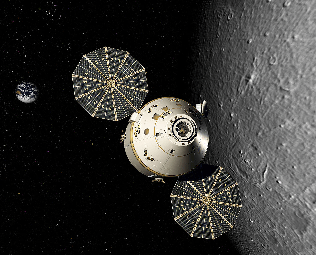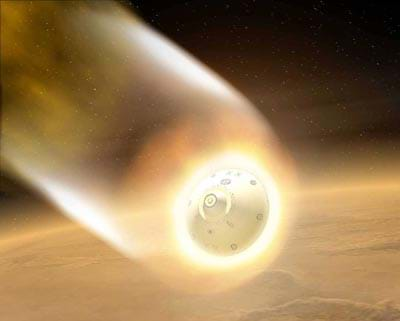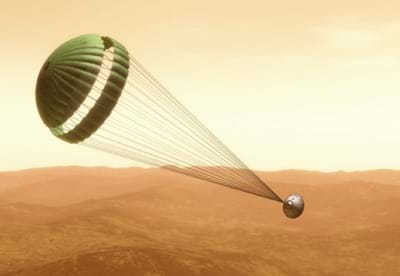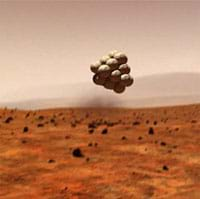Quick Look
Grade Level: 8 (6-8)
Time Required: 45 minutes
Lesson Dependency:
Subject Areas: Earth and Space, Science and Technology
NGSS Performance Expectations:

| MS-PS3-5 |

Summary
This lesson discusses how each component of a spacecraft is specifically designed so that a rover can land safely in six minutes. Also, students learn how common, everyday materials and technology, like nylon, polyester and airbags, are used in space-age technology.Engineering Connection
Engineers are experts at designing equipment and technologies for safety and protection. To endure the massive forces of entry and landing on Mars, engineers designed an aeroshell, parachute, rock thrusters, lander and airbag system. In our everyday lives, we see the benefits gained from smart engineering design: vehicle air bags, advanced braking systems, traffic lights, circuit breakers, GFI electrical outlets, factory air filters, motorcycle helmets, etc.
Learning Objectives

After this lesson, students should be able to:
- Describe the engineering process and steps of landing the rover safely.
- Identify how changes in kinetic energy must be controlled to ensure the craft isn't crushed.
- Identify several components of a Mars lander designed by engineers.
- Recognize that at extremely high speeds, atmospheric friction causes intense heating.
- Identify the different materials used for the parachute.
Educational Standards
Each TeachEngineering lesson or activity is correlated to one or more K-12 science,
technology, engineering or math (STEM) educational standards.
All 100,000+ K-12 STEM standards covered in TeachEngineering are collected, maintained and packaged by the Achievement Standards Network (ASN),
a project of D2L (www.achievementstandards.org).
In the ASN, standards are hierarchically structured: first by source; e.g., by state; within source by type; e.g., science or mathematics;
within type by subtype, then by grade, etc.
Each TeachEngineering lesson or activity is correlated to one or more K-12 science, technology, engineering or math (STEM) educational standards.
All 100,000+ K-12 STEM standards covered in TeachEngineering are collected, maintained and packaged by the Achievement Standards Network (ASN), a project of D2L (www.achievementstandards.org).
In the ASN, standards are hierarchically structured: first by source; e.g., by state; within source by type; e.g., science or mathematics; within type by subtype, then by grade, etc.
NGSS: Next Generation Science Standards - Science
| NGSS Performance Expectation | ||
|---|---|---|
|
MS-PS3-5. Construct, use, and present arguments to support the claim that when the kinetic energy of an object changes, energy is transferred to or from the object. (Grades 6 - 8) Do you agree with this alignment? |
||
| Click to view other curriculum aligned to this Performance Expectation | ||
| This lesson focuses on the following Three Dimensional Learning aspects of NGSS: | ||
| Science & Engineering Practices | Disciplinary Core Ideas | Crosscutting Concepts |
| Science knowledge is based upon logical and conceptual connections between evidence and explanations. Alignment agreement: Apply scientific ideas to construct an explanation for real-world phenomena, examples, or events.Alignment agreement: | When the motion energy of an object changes, there is inevitably some other change in energy at the same time. Alignment agreement: | Energy may take different forms (e.g. energy in fields, thermal energy, energy of motion). Alignment agreement: |
Common Core State Standards - Math
-
Fluently divide multi-digit numbers using the standard algorithm.
(Grade
6)
More Details
Do you agree with this alignment?
International Technology and Engineering Educators Association - Technology
-
Transportation vehicles are made up of subsystems, such as structural propulsion, suspension, guidance, control, and support, that must function together for a system to work effectively.
(Grades
6 -
8)
More Details
Do you agree with this alignment?
State Standards
Colorado - Math
-
Fluently divide multi-digit numbers using standard algorithms.
(Grade
6)
More Details
Do you agree with this alignment?
Colorado - Science
-
Use mathematical expressions to describe the movement of an object
(Grade
8)
More Details
Do you agree with this alignment?
-
Describe methods and equipment used to explore the solar system and beyond
(Grade
8)
More Details
Do you agree with this alignment?
Introduction/Motivation
How long does it take for a 12,000 mph speeding spacecraft to come to a stop? How about a spacecraft that is exceeding 16 times the speed of sound or 20 times faster than a speeding bullet? What would happen if a spacecraft that is housing a multi-million dollar Mars rover were to come to a very sudden stop on the surface of Mars at the end of its 6 month journey? Intuitively, we know that the rover would smash into tiny pieces if it crash landed on the surface of Mars, but do you know why? The reason is a transfer of energy from Kinetic Energy, the energy of an object due to that object's motion, to some other form. If an object moving 20 times faster than a bullet suddenly stops, all that kinetic energy immediately transfers to where the object meets the ground and the object is crushed. If we can gradually decrease the kinetic energy before the Mars rover reaches the ground then crushing can be avoided! Do you know how to slow down something moving faster than a bullet? NASA engineers know precisely what it takes to slow down and finally stop these spacecraft. Believe it or not, it takes only six minutes to bring a spacecraft to a full stop! Engineers use a combination of an aeroshell, parachute, rocket thrusters and airbags to safely slow down and land the spacecraft, rover and lander. When a spacecraft is traveling this fast, the friction of the atmosphere causes extreme heat on the spacecraft. The aeroshell, parachute and rocket thrusters prevent the spacecraft from burning up in the Martian atmosphere and crashing into the surface, while the airbags allow the lander to safely "bounce" its way to a stop in order to deploy the rover. Landing a rover can be a significant challenge! Encourage students to conduct the associated activity Egg-cellent Landing to simulate landing a Mars rover by designing and building an egg-lander and following an egg-drop scenario.
Lesson Background and Concepts for Teachers

A rover is carried through space in a spacecraft (which is separate from the actual launch vehicle, which is a rocket that propels a spacecraft into space). The spacecraft is designed to safely carry and maneuver the rover as it enters the Martian atmosphere and lands on Mars. Two major units of spacecrafts are the cruise stage and the entry, descent, and landing system (which includes the aeroshell). In short, a launch vehicle projects a spacecraft into space, where it spends up to 6 months traveling, or cruising, the millions of miles between Earth and Mars.
Forty-five days before entry into the Martian atmosphere, the cruise phase of traveling through space comes to an end, and several preparation steps are carried out to end this phase and begin the entry, descent and landing phase — also called "six minutes of terror" by NASA engineers. Watch NASA engineers describe these minutes at: https://www.youtube.com/watch?v=OHwUrxzrvtg (note: for this descent, it's seven minutes of terror, each descent protocol has its own time frame.)
Here is a description of the procedures during these 6 minutes for the Spirit and Opportunity rovers, which landed in 2004. Notice the similarities and the differences between these and the procedures described in the video above from 2012.
First, the spacecraft switches from medium-gain to low-gain antenna communication allowing engineers to more accurately track the spacecraft and support its safe delivery to the surface of Mars. Next, the spacecraft rotates so that its heat shield — which protects the rover from intense heat — faces forward. Finally, cruise stage separation begins, shedding over half of the spacecraft's weight, and the six minutes of terror commences.
The part of the spacecraft that remains after the cruise stage separates is called the entry, descent, and landing system and includes the aeroshell (see Figure 2), which is made up of two parts; a heat shield and a backshell. The heat shield is the flat-brownish half of the aeroshell, which serves two functions. First, as the name implies, it shields the spacecraft from heat caused by atmospheric friction. At 12,000 mph, the temperature of the heat shield will reach 1,447 °C (2,637 °F), which is as hot as the surface of the sun! Clearly, protection is needed. Second, since the shield's surface is flat and not very aerodynamic, it acts to slow the spacecraft down to about 1000 mph in four minutes. The white half of the aeroshell is termed the backshell, which holds the parachute, rockets, lander and rover.

Once the aeroshell's heat shield has slowed down the spacecraft, and it is about 30,000 ft above the Martian surface, a parachute is ejected from the backshell (see Figure 3). The parachute is made from two common fabrics: polyester and nylon. Polyester is used for a number of reasons: extremely strong, resists creasing, withstands moisture, and is able to resist acid; and nylon is used for a variety of reasons, also: absorbs energy, highly elastic and extensible, and resists tearing under shock loads. The parachute's bridle (the tethers that hold it to the backshell) are made of Kevlar, the same material used to manufacture bulletproof vests. Once the parachute is deployed, about 6 miles above the surface, the heat shield is detached and the lander disconnects from the backshell; while the lander is technically detached, it is actually still connected to the backshell by a 65 foot (20 meter) bridle, made of braided Zylon — an advanced fiber material similar to Kevlar that is sewn specifically in a webbing pattern (like shoelace material) to make it stronger. Once the lander/backshell separation occurs, airbags — made of synthetic Vectran, which has almost twice the strength of other synthetic materials, such as Kevlar, and performs better at cold temperatures — inflate to prepare for landing (Figure 4). Because the Martian atmosphere is very thin, the deployed parachute is not enough to slow the spacecraft's backshell; rockets are used to bring the spacecraft to a vertical stop, about 30-50 feet above the surface.

Fun Fact: Students should be familiar with the concept of the parachute but they may not know that the idea of a parachute dates back to Leonardo DaVinci (1452-1519). However, Louis Sebastien Lenormand is often credited for the invention of the first practical parachute in 1783. (http://inventors.about.com/od/pstartinventions/ss/Parachute.htm)
At this point, the spacecraft has slowed down from 12,000 mph to a vertical stop about four or five stories above the surface. However, arguably the most exciting and dangerous part of the landing is not over yet. The bridle is now cut and the 1,200 pound (544 kg) lander and rover will freefall to the Mars surface, marking the end of six minutes of nail biting terror for engineers.
The lander could bounce up to 10 minutes and make 30-40 bounces over a kilometer (more than half a mile) of the Martian surface before it finally comes to a stop and the airbags deflate. Finally, the pedals of the lander open up to expose the rover, which then deploys its solar array and raises its panoramic camera. Communication begins between the rover and the Mars Odyssey orbiter satellite, and the rover is ready to roam the Martian surface.

Associated Activities
- Egg-cellent Landing - Students simulate landing a Mars rover by designing and building an egg-lander and following an egg-drop scenario.
Lesson Closure
From other lessons in the Mission to Mars unit, we learned why scientists are so interested in studying Mars, how scientists and engineers design and manufacture a rover to gather scientific information, and how it is possible to transport the rover from Earth to Mars. This lesson described the steps and design for accomplishing one of the most difficult tasks of the mission: controlling how kinetic energy is transferred and landing the rover safely on Mars. Aerospace engineers had to design how the aeroshell, parachutes, and rockets would safely slow down the spacecraft while entering the Martian atmosphere. Materials engineers had to select advanced materials such as the nylon and polyester for the parachutes and Vectran for the airbags, while mechanical engineers had to design the structure of the lander and airbags for a cushioned landing and safe stop. Finally, electrical engineers and computer science engineers had to integrate all of the circuitry together for navigation and communication of the spacecraft. A great team of engineers created a state-of-the-art piece of equipment, the rover, which allows scientists to study the Red Planet remotely.
Vocabulary/Definitions
Aeroshell: The remaining spacecraft after its separation with the cruise stage. It is made up of two parts: a heat shield and a backshell.
Backshell: The white half of the aeroshell which houses the parachute, airbags, rockets, lander, and rover.
Bridle: Rope or chord-like tethers used to connect both the parachute and lander to the backshell.
Cruise stage: The configuration of the spacecraft for travel between Earth and Mars.
Heat shield: The brownish half of the aeroshell made to withstand temperatures as hot as the surface of the sun (1,447 °C or 2,637 °F).
Kinetic energy: Energy due to an objects motion.
Lander: Shell with airbags which protects the rover while bouncing along the Mars surface.
Rover: An unmanned vehicle sent to explore an unknown area.
Assessment
Pre-Lesson Assessment
Discussion Question: Solicit, integrate and summarize student responses.
- Ask the students what problems they might face when trying to land a 12,000 mph speeding spacecraft on another planet like Mars. (Possible answers: burning up in the atmosphere, slowing down the spacecraft, not crashing into the surface, or finding a safe place to land — i.e., not landing in an ocean if the planet had water.)
Poll: Before the lesson, ask all students the same question. Have students raise their hand to answer the question. Write answers (or key facts) on the board, and summarize (in percentages or actual number of students) who answered the same or similarly. Ask students:
- How long do they think it takes for NASA engineers to slow down and finally stop a 12,000 mph speeding spacecraft to 0 mph? (Answer: 6 minutes)
Post-Introduction Assessment
Deceleration Calculation: Calculate an equation, and summarize student responses. Write the correct answer on the board.
- The deceleration of a stopping object can be calculated by dividing the velocity (or speed) of the object by how long it takes to stop. With velocity in mph and time in seconds, what is the deceleration of the spacecraft to stop?

(Answer: 33.33 mph/sec.)
This means on average the spacecraft slows down 33 mph every second, which is almost twice as hard as someone slamming on their brakes in a car.
Lesson Summary Assessment
Human Matching: On 14 pieces of paper, write either the term or the definition of the eight vocabulary words. Ask for 16 volunteers from the class to come up to the front of the room, and give each person one of the pieces of paper. One at a time, have each volunteer read what is written on his/her paper. Have the remainder of the class match term to definition by voting. Have student "terms" stand by their "definitions." At the end, give a brief explanation of the concepts.
Question/Answer: Have students answer the following questions in a short paragraph in journals or on a sheet of paper:
- What three components help slow the spacecraft during entry into the Martian atmosphere? (Answers: The aeroshell's heat shield, because of its non-aerodynamic shape, a parachute, and rockets.)
- Why is it important to slow the spacecraft before it lands? (Answer: to control the transfer of kinetic energy)
- What common clothing materials are used in making the parachute? (Answer: polyester and nylon)
- After the lander is cut from the backshell and free falls to the surface of Mars, it bounces to a stop. About how many bounces are necessary before the lander fully stops? (Answer: 30 – 40 bounces)
Lesson Extension Activities
Entry, Descent, and Landing Comparison– Add the Mars 2020 Entry, Descent, and Landing to the students comparison with those of Curiosity, Spirit and Opportunity.
Resources:
Subscribe
Get the inside scoop on all things TeachEngineering such as new site features, curriculum updates, video releases, and more by signing up for our newsletter!More Curriculum Like This

Students are introduced to the planet Mars. They begin by discussing the location and size of Mars relative to Earth, as well many interesting facts about this "red planet." Next, the history of Martian exploration is reviewed and students discover why researchers are so interested in studying this ...

Students recreate the classic egg-drop experiment with an analogy to the Mars rover landing. Students design and build their lander within a pre-determined budget to help reinforce a real-world design scenario.

During this lesson, students discover the journey that a Mars rover embarks upon after being designed by engineers and before being prepared for launch. Students investigate the fabrication techniques, tolerance concepts, assembly and field-testing associated with a Mars exploratory rover.

Students acquire a basic understanding of the science and engineering of space travel as well as a brief history of space exploration. They learn about the scientists and engineers who made space travel possible and briefly examine some famous space missions.
References
http://marsrovers.jpl.nasa.gov/home/index.html
http://inventors.about.com/od/pstartinventions/ss/Parachute.htm
http://www.it-adventures.org/it-olympics/
http://inventors.about.com/od/astartinventions/a/air_bags.htm
http://www.jcfa.gr.jp/english/index_e.html
http://www.kubicekballoons.cz/english/products/balloons.php
Copyright
© 2004 by Regents of the University of Colorado.Contributors
Chris Yakacki; Geoffrey Hill; Daria Kotys-Schwartz; Malinda Schaefer Zarske; Janet YowellSupporting Program
Integrated Teaching and Learning Program, College of Engineering, University of Colorado BoulderAcknowledgements
The contents of this digital library curriculum were developed under a grant from the Fund for the Improvement of Postsecondary Education (FIPSE), U.S. Department of Education and National Science Foundation GK-12 grant no. 0338326. However, these contents do not necessarily represent the policies of the Department of Education or National Science Foundation, and you should not assume endorsement by the federal government.
Last modified: July 26, 2022









User Comments & Tips